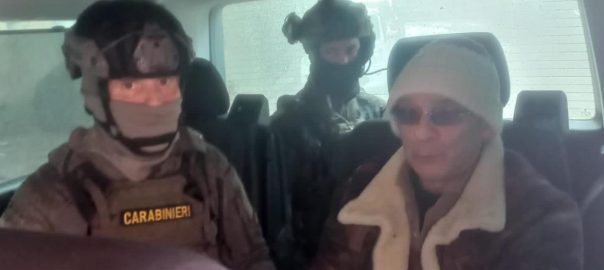Felia Allum, University of Bath
Matteo Messina Denaro, one of the leaders of the Sicilian mafia, the Cosa Nostra, has finally been detained after 30 years on the run. His arrest came as around 100 police officers surrounded the private Maddalena clinic in Palermo where they had discovered he was receiving treatment.
Rumours had been rife for weeks that Denaro was ill and having chemotherapy – but it came as a surprise to the public that Italy’s most wanted man was having treatment in a Palermo clinic alongside ordinary citizens. He was in the queue for tests when a police officer approached him to ask him who he was. An associate standing with him made a run for it but he came forward and simply answered “I am Matteo Messina Denaro”.
Investigators explained at their press conference that it was his need for healthcare that finally enabled them to identify him and move in.
Denaro’s arrest on January 16 came exactly 30 years and one day after the arrest of his mentor, the boss, Toto “the Beast” Riina. It seems significant that after three decades on the run, this was the date the state finally managed to catch up with him. It may indicate that the internal dynamics of Cosa Nostra are changing and that someone had decided to give him up because he was no longer considered “useful”.
Denaro is the last boss who knows all the secrets surrounding Cosa Nostra’s terrorist attacks on the state of the early 1990s. Were he to talk, he could provide essential pieces to the post-war Mafia puzzle. This is very unlikely, however, so anyone hoping for closure or the truth may well be disappointed.
His arrest is also a worrying reminder for authorities about the current state of play. His is the last known face of Cosa Nostra’s leadership. Investigators know less about what current leaders look like and will now be fighting with one hand tied behind their back as they look for other mafia suspects.
A bridge between the old and new school
Denaro was the last of the old generation mafia bosses. He represents the final link between the belligerent and overt Cosa Nostra of the early 1990s and the silent, business-like mafia of the 21st century. He was born into a mafia family and was known for his violence but he also moved in the “right” circles for progressing his career.
He is the last mafia boss who associated with the Corleone generation, a group of mafiosi (led by Riina and Bernardo Provenzano) that essentially conducted out-and-out war on the Italian state in the early 1990s. The conflict caused numerous violent deaths such as of judges Giovanni Falcone and Paolo Borsellino and of Giuseppe Di Matteo, the 12-year-old son of a turncoat, who was kidnapped, strangled and dissolved in acid to force his father to backtrack on his collaboration with the state.
Considered to be less conservative than traditional and older leaders, Denaro was flashier and more modern. He was able to direct the Cosa Nostra from 2007 until his arrest by infiltrating the legitimate economy through front companies. While Riina adopted a terrorist strategy towards the state, Denaro’s mafia brand encapsulates the 21st century: it is based on a mixture of violence, illegal activities, social solidarity (providing jobs and justice to local communities), silence and anonymity. Solid business and political contacts are also crucial, especially the capacity to reinvest “dirty money” into the legitimate economy.
In recent years, it has even been suggested that Denaro was investing in innovative and forward-looking businesses (such as wind and solar energy companies). All this is abetted by a large network of enablers and facilitators who have protected Denaro for the past 30 years. These are often likely to be people with no criminal record of their own, so are less traceable by the authorities.
The existence of such trusted support networks within Denaro’s mafia is a crucial issue for the authorities. It shows still the existence of a layer of omertà – silence – that protected him. This arrest is a clear victory for the Italian state, but it must be asked why it took so long to find Denaro in Sicily. His protective circle has evidently been hard to break down.
The police have slowly been able to remove these layers of accomplices which made him vulnerable – but it has taken time. The Italian police has come to rely on both traditional monitoring and more modern digital and telephone intercepts when investigating mafia networks. These eventually proved successful.
The end of Cosa Nostra – or a new era?
Denaro’s arrest could well produce a power vacuum that throws the Cosa Nostra into crisis – but this is not the end of the mafia. The fall of Denaro might even create an opportunity for it to mutate once again, change and adapt to new business opportunities, like a snake changes its skin. I believe that this arrest marks a change of the guard for the leadership of Cosa Nostra. It may be that Denaro was no longer relevant or needed. Maybe, he had even outlived his usefulness. A new generation will already be in place managing Cosa Nostra.
Many people may now declare Cosa Nostra dead. Clearly, it is not as healthy as Italy’s other main organised crime gangs – the Calabrian ‘Ndrangheta and Neapolitan Camorra, both of which are thriving – but it is far from a lost cause. Even after Denaro’s downfall, the Cosa Nostra continues to function, permeating the Italian economy and the economies of plenty of other European nations. Therefore, the Italian state and European countries must relentlessly continue their fight against mafias and organised crime groups and never let their guard down.
Felia Allum, Professor of comparative organised crime and corruption., University of Bath
This article is republished from The Conversation under a Creative Commons license. Read the original article.

